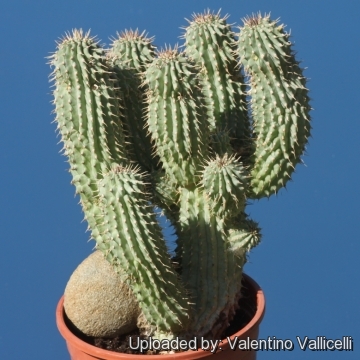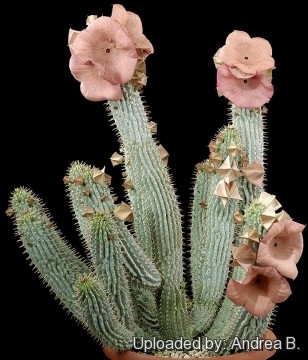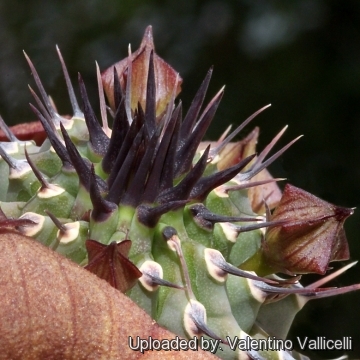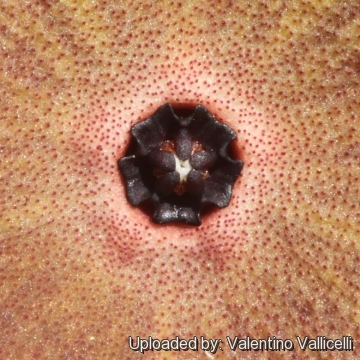Accepted Scientific Name: Hoodia gordonii (Masson) Sweet ex Decne.
Prodr. [A. P. de Candolle] 8: 665. 1844 [mid Mar 1844] see also: Sweet in Hort. Brit. [Sweet], ed. 2. 359. 1830 DC. et al.

Stapelia gordonii (Hoodia gordonii) Photo by: K.k. Agrawal
It has been called one of the ''wonder plants'' of the twenty first century, widely used as an appetite suppressant in slimming pill. It produces large disk shaped flowers, with a very unpleasant smell.
Origin and Habitat: It grows naturally in a very wide area of the Kalahari desert in South Africa and Namibia. It is also found in the deserts of Botswana and Angola.
Habitat: Grows in winter-rainfall regions in deep Kalahari sands, on dry stony slopes or flats often under the protection of xerophytic bushes but it has a wide tolerance of growing habitats. In places where the temperature soars past 50°C , but it can survive in relatively low temperatures (-3°C). This area is home to a wide range of unique plant species.
Ecology: : Pollination is done mainly by flies. This unusual pollination biology is referred to as myophily (pollination by flies). Myophily takes place in some of the following genera, Stapelia, Huernia and Ceropegia. Life for a young Hoodia plant begins under the protection of a nurse plant. A nurse plant is a shrub under which the young plant germinates and grows, protected by its leaves and branches from the suns strong rays.
Synonyms:
See all synonyms of Hoodia gordonii
back
Accepted name in llifle Database:Hoodia gordonii (Masson) Sweet ex Decne.Prodr. [A. P. de Candolle] 8: 665. 1844 [mid Mar 1844] see also: Sweet in Hort. Brit. [Sweet], ed. 2. 359. 1830Synonymy: 15
Accepted name in llifle Database:Hoodia gordonii f. cristata hort.
back
Common Names include:
ENGLISH: Hoodia, Kalahari cactus, African Hats, Queen of the Namib, Bushman's Hat
AFRIKAANS (Afrikaans): Gap, Ghap, Bitter Ghaap, Bokhorings, Bitterghaap, Bergghaap, Bobbejaanghaap, Ghaap, Ngaap, Guaap, Gnaap
HEBREW (עברית): הודיה גורדוני
KHOI: Khobab
SWEDISH (Svenska): Flugtallrik
Description: Hoodia gordoniiSN|10582]]SN|10582]] is a leafless fat-stemmed and spiny succulent plant similar to a cactus. In the early stages only one stem is produced but at a later stage the plant produces clusters of green upright stem. Mature plants can have as many as 50 individual branches and weigh as much as 30 kg. Plants under ideal conditions can attain a height of 1 metre. Hoodia gordoniiSN|10582]]SN|10582]] can under ideal conditions live for 25 years in cultivation. In the wild they probably don't live much longer than 15 years.
Stem: 0,5-1 m tall, greyish-green to pale brown, strictly cylindrical, 2,5-5 in diameter. The knobbly surface helps to scatter the sun's radiation, minimising the amount of heat they absorb.
Tubercles: Protruding, blunt, arranged in 11-17 ribs. Apically with an acute spine.
Spine: 6-12 mm long.
Flower: Saucer-shaped, strictly 5-lobed with a central depression, large up to 75 mm, pale straw, pale purple to dark maroon coloured and usually with darker venation (vaguely resembling a petunia flower) borne on or near the terminal apex (top part of the plant), inflorescence very shortly pedunculate, with group of 1-4 flowers. The flowers smell like rotten meat and are pollinated mainly by flies.
Blooming season: Flowers are normally borne in August or September. Hoodia takes duration of 5 years to be completely mature, till its flowers appear.
Fruits: The seed capsules resemble small antelope or goat horns.
Seeds: The seeds are light brown in colour, are flat and have a pappus of fluffy hair attached to their one end. This pappus acts as a parachute when the seed pod splits open. The seeds are blown some distance from the parent plant where they will establish themselves.
Remarks: There are many difficulty in Hoodia identification. If we have some plants from unidentified origin ( plants provided unlabeled or with poor identification data), we have to wait until the plant is in flower and also specialists and growers have quite a difficulty to identify correctly this plants.
Subspecies, varieties, forms and cultivars of plants belonging to the Hoodia gordonii group
 Hoodia bainii Dyer: has stems covered with tubercles, ending in woody spines. Flowers are, buff coloured, fading to purple, often smaller than in H. gordonii. Distribution: Namaqualand, Karoo
Hoodia bainii Dyer: has stems covered with tubercles, ending in woody spines. Flowers are, buff coloured, fading to purple, often smaller than in H. gordonii. Distribution: Namaqualand, Karoo  Hoodia gordonii (Masson) Sweet ex Decne.: has spiny stems similar to a cactus. Flower saucer-shaped to 75 mm across, pale straw, pale purple to dark maroon with darker venation. Distribution: Kalahari desert in South Africa, Namibia, Botswana and Angola.
Hoodia gordonii (Masson) Sweet ex Decne.: has spiny stems similar to a cactus. Flower saucer-shaped to 75 mm across, pale straw, pale purple to dark maroon with darker venation. Distribution: Kalahari desert in South Africa, Namibia, Botswana and Angola. Hoodia gordonii f. cristata hort.: crested form.
Hoodia gordonii f. cristata hort.: crested form.
Bibliography: Major references and further lectures
1) G. J. H. Grubben "Vegetables" PROTA, 2004
2) Kristo Pienaar “The South African what Flower is That?” Struik, 2000
3) Werner Rauh “The Wonderful World of Succulents: Cultivation and Description of Selected Succulent Plants Other Than Cacti” Smithsonian Institution Press, 1984
4) Ramon Folch i Guillén, Josep Maria Camarasa “Encyclopedia of the Biosphere: Deserts” Gale Group, 2000
5) Focke Albers, Ulrich Meve “Illustrated Handbook of Succulent Plants: Asclepiadaceae” Volume 4 Springer, 2002
6) James Cullen, Sabina G. Knees, H. Suzanne Cubey “The European Garden Flora Flowering Plants: A Manual for the Identification of Plants Cultivated in Europe, Both Out-of-Doors and Under Glass” Cambridge University Press, 11/ago/2011
7) Bruyns, P,V. “Stapeliads of Southern Africa and Madagascar.” Umdaus Press, Hatfield, South Africa. 2005.
 Stapelia gordonii (Hoodia gordonii) Photo by: Raimondo Paladini
Stapelia gordonii (Hoodia gordonii) Photo by: Raimondo Paladini Stapelia gordonii (Hoodia gordonii) Photo by: Valentino Vallicelli
Stapelia gordonii (Hoodia gordonii) Photo by: Valentino Vallicelli Stapelia gordonii (Hoodia gordonii) Photo by: Valentino Vallicelli
Stapelia gordonii (Hoodia gordonii) Photo by: Valentino Vallicelli Stapelia gordonii (Hoodia gordonii) Photo by: Andrea B.
Stapelia gordonii (Hoodia gordonii) Photo by: Andrea B. Stapelia gordonii (Hoodia gordonii) Photo by: Valentino Vallicelli
Stapelia gordonii (Hoodia gordonii) Photo by: Valentino Vallicelli Stapelia gordonii (Hoodia gordonii) Photo by: Andrea B.
Stapelia gordonii (Hoodia gordonii) Photo by: Andrea B. Stapelia gordonii (Hoodia gordonii) Photo by: Valentino Vallicelli
Stapelia gordonii (Hoodia gordonii) Photo by: Valentino Vallicelli Stapelia gordonii (Hoodia gordonii) Photo by: Valentino Vallicelli
Stapelia gordonii (Hoodia gordonii) Photo by: Valentino VallicelliCultivation and Propagation: Hoodia gordonii is one of easiest species to grow but prone to root rot due to overwaterings and lack of fresh air.
Esposure: Indoors only in brightest position.
Watering: Water normally in the growing season, sparsely in the winter.
Hardiness: It is usually recommended to over-winter them in warm conditions (at 10° C), but despite their African origins they seem to grow well and flower without the extra heat which one might have thought necessary, and occasional temperatures near 0°C (or less) are tolerated, if kept dry.
Spring: In the spring leaving them out in the rain may provide them with the water they need.
Summer: In the summer months they will grow well in full sun or partial shade and tolerate heavy rain, but will be just as happy if the season is dry.
Potting medium: Since roots are quite shallow, a gritty, very free-draining compost with extra perlite or pumiceis suitable, and clay pots help the plants to dry out between watering.
Medicinal uses: Hoodia gordoniiSN|10582]]SN|10582]] has long been known by the indigenous populations of Southern Africa that have been using it for centuries to stave off hunger during their long and arduous hunting trips in the harsh South African wild and also for treating indigestion and small infections. Nowadays Hoodia is used as a component in diet pills that leads to the purpose of weight loss and is remarkably wanted in developed countries. It has been called one of the "wonder plants" of the twenty first century. The stems of Hoodia plants that have had their spines removed are the preferred portion of the Hoodia plant for eating. Some manufacturers of dietary supplements describe the use of stems in their slimming pill , but this statement is quite inaccurate, because it is the whole aerial part of the plant that is dried for the preparation of bulk Hoodia powder. Hoodia species have a bitter taste, which is quite noticeable after eating.
Edible uses: Commonly known as: “ghaap” the young pods are liked for their sweetniss.
Propagation: Propagation is done mainly from seed. Cuttings are not really an option, as the severed ends very rarely form a callus from where roots will eventually form. Seeds are produced in March and April of each year (Europe). The seed horns must be semi-dry and starting to split down the middle before seed can be collected. If you try to take a cutting allows it to dry several days before planting.
Your Photos

by Xero Sicyos

by Valentino Vallicelli

by Valentino Vallicelli

by Valentino Vallicelli

by Valentino Vallicelli























